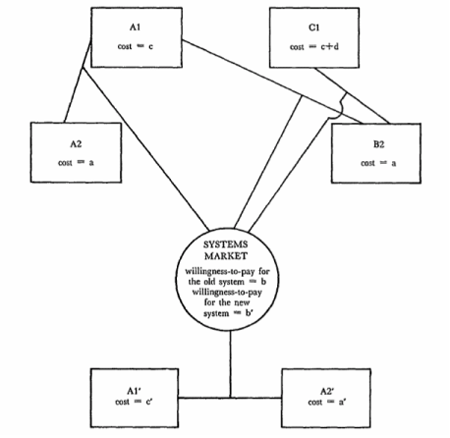Robert D. Willig Presentation
Slide 1
(Allegedly) Monopolizing Tying
Via
Product Innovation
Robert Willig
Princeton University
Compass
Slide 2
Tough to Assess Monopolization
- Practices can harm competition and consumers by seriously weakening ability of rivals to compete effectively.
- Practices can be good for consumers and be an intrinsic part of competition.
- Innovation is particularly valuable to consumer welfare, and particularly vulnerable in its incentives.
Slide 3
Two Phases for Assessing
Monopolization
- Has the challenged practice harmed competition (or is there a dangerous probability that it will)?
- If the challenged practice has harmed competition,
- is the practice part of competition?
- does the practice "make economic sense?"
- is there a sound business rationale?
- OR, is the harm to competition "willful?"
- is there "sacrifice of profit?"
Slide 4
Harm to Competition
From the Tie?
- Are consumers impelled to buy the tying good, and thus the tied good, by market power?
- Highly limited substitutes for the tying good?
- Highly limited substitutes for the tying-tied goods together?
- Does the ensuing unavailability of the tied sales to rivals harm competition?
Slide 5
Harm to Competition
From the Tie?
- Identify the relevant market and its participants.
- Has the unavailability of the tied sales eliminated or significantly weakened rivals who are scarce and irreplaceable?
- Loss of share or margins of rivals is Not Enough
- Have the tying-tied sales been good deals?
- Have prices gone up and alternatives degraded outside of the tying-tied products?
- Is enough of the market unaffected by the tying for rivals to get needed scale economies from there?
- Has rivals' R&D dried up due to loss of scale economies?
- Were rivals inefficient and weakening anyway?
Slide 6
Is the Challenged Tie Part of
Competition?
- Since competition is the valid policy goal, business conduct that is part of competition should not be held as monopolizing.
- Would the challenged tie make business sense - be profitable - without taking into account any added monopoly power from weakening rivals?
Slide 7
Tying Via Product Innovation:
"Technological Tying"
- New product design ties two components of a system that might otherwise be "open"
- Potentially competitive component is thus technologically tied to bottleneck tying component.
- Rivals are shutout of system, possibly creating market power over tied components in non-coincident markets, and possibly preserving bottleneck market power.
- New product design may be a welfare-increasing innovation!
Slide 8
Slide 9
Optimal Policy for Social Welfare
- The "compensatory price" for the open-design bottleneck is defined as that which earns the same margin as the market price for the new system.
- Theorem: With compensatory pricing of the open-design bottleneck, the technological tie can eliminate the competitors if and only if the new closed system is socially superior to the open one, ex-post the R&D costs.
- Ordover and Willig, "An Economic Definition of Predation: Pricing and Product Innovation," Yale Law Journal, 1981.
Slide 10
Optimal Policy for Social Welfare
(continued)
- Theorem: Taking into account the R&D costs, the new closed system is socially superior to the open one if and only if it raises profits for the innovator under compensatory pricing of the open-design bottleneck.
- Ordover and Willig, "An Economic Definition of Predation: Pricing and Product Innovation," Yale Law Journal, 1981.
Slide 11
Optimal Policy for Social Welfare
(continued)
- In other words, if a technological tie is accompanied by compensatory pricing of the open design, the theorem proves the new system is better if it profitably kills off the competitors.
- If the open design is not preserved, but its compensatory pricing would not alter market outcomes, then the results of the theorem still apply.
- If the technological tie kills off competitors, but the R&D and other costs are not worth the incremental net revenues but-for the monopolization, then social welfare is lowered by the new design.
Slide 12
Important Caveats
- How can a fact-finder assess the expected R&D costs?
- How can a fact-finder assess the impacts of the tie if there were (as a but-for) also an open system with compensatory pricing?
- But, without this approach, how could a fact-finder assess whether the closed system design is socially superior to the hypothetical open one?
Slide 13
More Important Caveats
- The theorems rely on a setting where there are no other issues for social welfare besides the possible monopolizing tie.
- Economics teaches that innovation brings complicating ambiguous externalities:
- Benefits to consumers and to imitators that the innovator cannot appropriate
- Diversions of sales and profits from differentiated rival products
- So it is unknown how competitive and technological tying conduct in an actual market compare to first-best innovation.
Slide 14
Policy Bottom Line
- As a matter of economic logic, technological tying is a real possibility, and there may be genuine incentives to do so for pro or anti competitive reasons.
- There are logical and intuitive tests and standards for assessing product design for monopolization via tying. These are tough to apply, so great humility is called for.
- To protect innovation from stultifying litigation, strict and demanding hurdles should impose tough discipline on antitrust intervention vis technological tying.
- See D. Gaynor's FTC working paper "Technological Tying" for a similar conclusion based on a price-discrimination model.

 U.S. Department
of Justice
U.S. Department
of Justice

